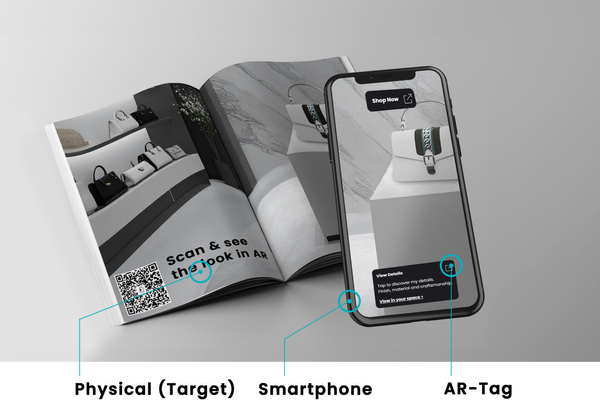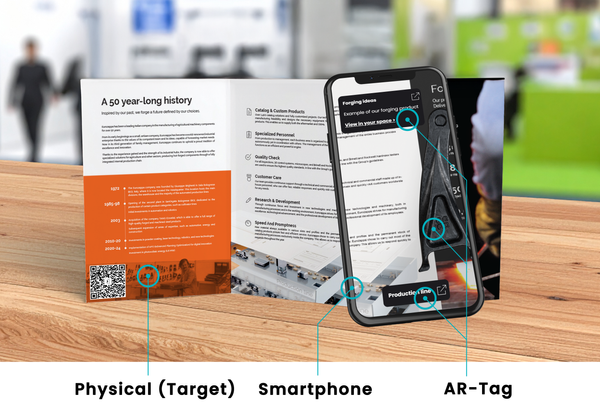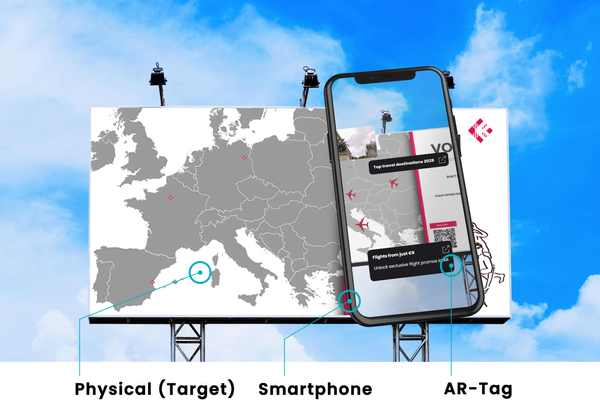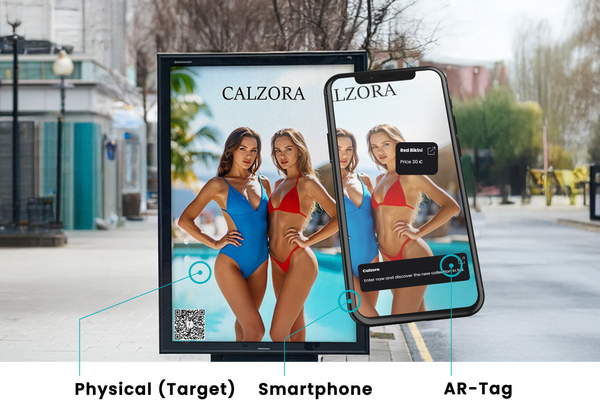Augmented Reality in Furniture E-commerce: A Starter Guide
This guide offers furniture industry companies an introduction to leveraging 3D visualization and augmented reality (AR) to enhance their e-commerce platforms. It highlights the benefits, covers the two main approaches to AR (web and app based) and outlines the key points for a successful approach.
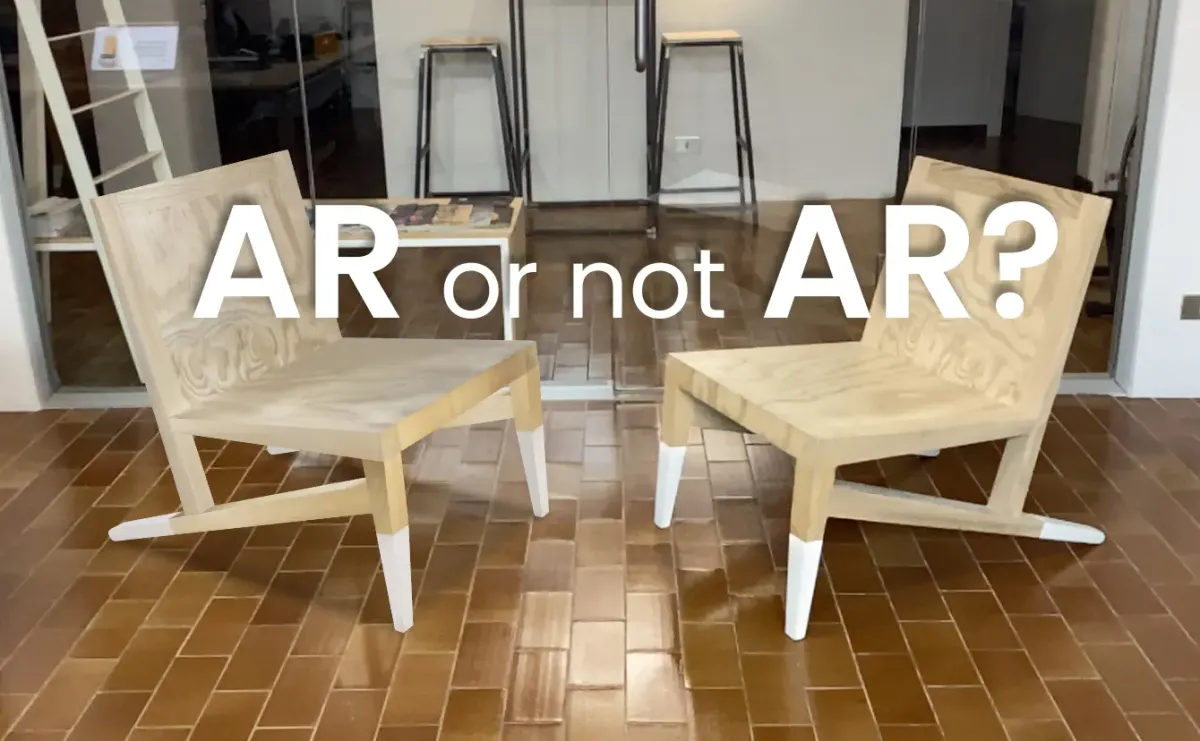
Introduction
Welcome to the world of furniture shopping enhanced by Augmented Reality (AR). No longer an abstract concept, AR is rapidly becoming a strategic imperative in the e-commerce sector, with an undeniable influence on the consumer shopping experience.
As we delve deeper, we'll illuminate the cornerstone role of AR in creating a seamless bridge between the physical and digital world, fostering a new dimension of e-commerce interactions that are safer, more convenient, and fun to explore!
The Evolution of Online Furniture Shopping
Imagine the early days of online shopping, a time when your decision to purchase a sofa, a desk, or any piece of furniture was dependent on flat, static images. These 2D pictures provided a basic idea of what an item looked like but limited by their inability to convey depth, texture, or how an object might fill a space. It was, in essence, a guessing game of dimensions and aesthetics—a leap of faith that what you saw on screen would match your expectations in reality.
As technology advanced, the introduction of 3D modeling marked the next significant leap. Through 3D visuals, online shoppers were given a better perspective. You could now rotate an object, view it from various angles, and get a somewhat clearer idea of its scale and the intricacies of its design. Though more informative than 2D images, 3D models were still confined to the digital landscape. They sat on your screen, waiting for you to mentally project them into your living space. The interaction remained largely one-sided, with the digitized environment failing to interact meaningfully with your physical world.
Then, enter the realm of Augmented Reality (AR). AR technology builds on and far surpasses the static 2D images and the more dynamic but still limited 3D models. It brings a revolutionary way to shop for furniture online by adding the critical third dimension of depth, turning viewing into experiencing. Augmented Reality doesn't just show you an object in a better light; it virtually places it in your room. With the camera on your phone or tablet, AR technology overlays a three-dimensional, digital model of your chosen piece of furniture onto your live room view. This seamless weaving together of the digital and physical worlds allows you to walk around the virtual piece, view it from every angle, and truly picture how it fits into your existing space—not just in terms of dimensions but also style, color, and feel.
This evolution from 2D to AR embodies a leap from imagining to seeing, from guessing to knowing. Now, the ability to visualize exactly how a new couch will look against your living room wall, or whether a new bed frame will match your bedroom's decor, is at your fingertips. Augmented Reality effectively dissolves the barriers between the digital and physical, inviting consumers to engage with products in their homes before making a financial commitment. It's not just about viewing or rotating a product; it's about placing it in your life, ensuring compatibility, and thereby fostering confidence in your purchase decisions.
How Augmented Reality Works
Curious about the inner workings of this artistic fusion between the technology and your shopping experience? Augmented Reality operates on the principle of superimposition, enhancing your real world with virtual 3D objects using AR tools and technologies. User-friendly and innovative, AR offers a truly interactive shopping journey, elevating your e-commerce experience while ensuring your confidence in your purchases. Learn more in our article: https://www.myarstudio.cloud/explore/how-augmented-reality-really-works/
Are 3D and Augmented Reality usable today?
Starting with the simpler aspect: regarding 3D visualization, it can be stated that if a device (desktop, laptop, tablet or smartphone) is capable of internet browsing, then it should also be able to display a 3D model.
Considering a B2C perspective, the AR-compatible devices are smartphones and tablets, dominated by two major platforms: ARKit (iOS) and ARCore (Android).
ARKit, Apple's AR platform, boasts compatibility with approximately 1.411 billion devices. This means that almost every Apple's user can experience advanced AR functionalities (since iPhone7, iOS11).
On the other hand, ARCore, Google's counterpart for embedding augmented reality in Android ecosystems, is not far behind, with compatibility reaching around 1.405 billion devices (since Android 7).
This near parity in numbers reflects the widespread adoption and integration of AR technologies across the leading mobile operating systems, highlighting the massive potential audience for AR applications and experiences in the global smartphone market.
This data refers to July 2023 and the numbers continue to grow. For further details visit: https://arinsider.co/2023/07/17/mobile-ar-users-break-the-billion-barrier/
With this data at hand we could say all of your customers that you can reach digitally can visualize a 3D model and most of them have an AR capable device.
Benefits of AR in Furniture Retail
Augmented Reality isn't just high-tech fun; it brings solid benefits to the shopping experience. Here are some benefits you can expect from a well designed AR experience:
- Boosted Customer Engagement and Satisfaction: AR transforms passive browsing into an interactive and personally tailored shopping experience.
Ikea App experience: Ikea's AR app allows users to visualize what Ikea products will look like in their home before buying. Reports and reviews indicate that such tools lead to greater customer satisfaction because they help customers make better-informed decisions.
Many market studies have found that AR apps in retail can lead to increased engagement. Most shoppers prefer to shop at stores that offer AR experiences, and many of them would pay more for a product if they could experience it through AR.
- Reduced Return Rates: with accurate visual representations of the furniture, customers are less likely to experience ‘buyer's remorse'.
Academic research suggests that providing more accurate and rich visual information can reduce returns because it leads to better expectations about the product. AR enables customers to interact with a true-to-scale 3D model of the product in their actual space, thus aligning expectations with reality.
- Improved Conversion Rates: a great AR experience results in faster decision making, creating a higher likelihood for customers to 'add to cart'
Some furniture retailers have shared their performance metrics, indicating that consumers who engaged with AR were more likely to make a purchase: merchants who added 3D content to their stores saw a significant lift in conversion rates. Shopify, for instance, reported that interactions with 3D/AR content had a 94% higher conversion rate compared to products without AR/3D. https://changelog.shopify.com/posts/shop-adds-3d-and-augmented-reality-ar-previews
Exploring AR Adoption: Case Studies in Furniture Retail
Let’s consider two celebrated examples of furniture brands that have been at the forefront of adopting AR technology: Crate and Barrel and Ikea. While both have embraced this technological advancement to enhance the customer experience, they have taken distinct routes in integrating AR into their sales strategies. Crate and Barrel has opted for a web-based AR experience, making it seamlessly accessible to consumers without the need for additional applications. On the other hand, Ikea has pioneered an app-based AR approach, diving into the app ecosystem to provide a dedicated and feature-rich platform for their customers. Let's take a closer look at how each of these industry leaders has implemented AR and the impact it has had on their interaction with consumers.
Crate and Barrel's Web-Based AR Journey
Crate and Barrel recognized the potential of AR early on, choosing a web-based approach to minimize friction for their customers. Their AR strategy allows shoppers to instantly place 3D models of furniture into their actual living spaces directly from Crate and Barrel's website, with no downloads or apps required. This streamlined process offers the convenience of viewing and rearranging multiple products through a browser on any AR-enabled smartphone or tablet. By integrating AR into the web shopping experience, Crate and Barrel has positioned itself to take full advantage of this technology's ease of use, thus enhancing customer satisfaction and encouraging a more confident purchasing decision.
You can have a look at their catalogue with more than 5.000 articles available in 3D and AR here: https://www.crateandbarrel.com/special-features/ar-furniture/1
Ikea's Innovative App-Based AR Experience
Ikea, a giant in the world of ready-to-assemble furniture, has taken a different route by developing its own app-based AR experience. The Ikea Place app allows customers to browse through a wide selection of furniture, select pieces they're interested in, and virtually place them into their homes with high accuracy and realistic room-scale visualization. This app-centric approach has enabled Ikea to offer a more comprehensive AR experience, complete with the ability to save room setups, view items in different colors and materials, and access an extensive catalog of 3D furniture models. Ikea's dedication to creating a robust app is a testament to its commitment to innovation, improving customer engagement, and investing in technologies that enable a deep dive into the future of furniture retail.
Here you can find their mobile apps: https://www.ikea.com/us/en/customer-service/mobile-apps/
See our dedicated article to Ikea’s journey in AR.
Getting Started with AR in Furniture E-commerce
You don't need to be a large corporation to start integrating 3D and AR technologies into your business. The technology is stable and these innovative tools have become more accessible and affordable, enabling small and medium-sized enterprises to compete with bigger brands.
For a furniture company considering stepping into the future of digital retail, the journey towards implementing 3D visualization and AR technology unfolds in a strategically planned sequence, ensuring that the transition not only elevates the customer experience but also aligns with the company's digital engagement goals.
- Understanding 3D and AR: The initial step involves recognizing that choosing between 3D and AR isn't necessary; they complement each other. Once a company has invested in creating 3D models of its products, implementing AR becomes a natural progression. This revelation highlights that the real power lies in leveraging these technologies together to provide immersive and interactive experiences for customers.
- Creating 3D Models: The crux of a successful transition to 3D and AR lies in having high-quality 3D models of the furniture. This step is pivotal as it determines the quality of the virtual experiences customers will have. Accurate and detailed 3D models are essential for a realistic portrayal of products in the virtual space, allowing customers to explore textures, colors, and dimensions as if they were viewing the furniture in person.
- Choosing the Right Platform - Web-Based vs. App: For furniture companies with an established online presence, enriching the customer experience with 3D and AR doesn't necessitate building a separate app; a web-based approach can be equally effective. Integrating 3D and AR capabilities directly into the company's website simplifies access for customers, eliminating the need for additional downloads and seamlessly integrating with the existing online shopping journey.
- Monitoring Impact: Implementing these technologies should be followed by a period of careful monitoring to assess their impact on customer engagement, satisfaction, and ultimately, sales. Analyzing user interactions with 3D and AR features, gathering feedback, and examining conversion rates will provide valuable insights. This data-driven approach enables the company to iteratively refine and optimize the digital customer experience, ensuring that the investment in 3D and AR technologies delivers tangible business benefits.
By systematically following these steps, a furniture company can transform its digital presence, offering a compelling, interactive shopping experience that sets it apart in a competitive market.
Cost Analysis: Investing in AR for E-commerce
Venturing into the 3D+AR realm does bring initial costs, depending on the level of digitalization of your company it can be very little or bring you to an evolutionary journey. Let’s analyze together the main cost areas.
3D models: the key element
The foundation for integrating AR technology and 3D visualization into your marketing and sales strategy is having the 3D models of your products. Having accurate and detailed 3D models is essential as these serve as the virtual replicas of your physical products in the digital space. These models allow your customers to interact with, examine, and understand your products in an immersive environment that a simple photo or video cannot provide. Having high-quality 3D models is the crucial first step, as it enables you to leverage these models across various applications, including AR experiences, virtual showrooms, and interactive web features.
Depending on the level of digitalization of your company, this can cost little or bring you to an evolutionary journey. For companies already utilizing CAD and 3D models, there's a seamless transition into harnessing these assets for marketing and sales. You can make a quick assessment of the situation of your company by viewing this page: https://www.myarstudio.cloud/how-to-start
Investing time and resources into developing these 3D models can significantly enhance your marketing efforts, providing a more engaging and informative customer experience that can drive sales and build brand loyalty.
Model Optimization
Optimizing 3D models for web visualization and AR is of paramount importance for ensuring a seamless and engaging user experience. The balance between maintaining high-quality visuals and achieving fast loading times is crucial, as it directly impacts user engagement and satisfaction. In a digital era where consumers expect instantaneity, optimizing 3D models to load quickly while still delivering a visually rich experience is essential. This optimization process involves reducing file sizes without compromising on the detail and quality that give the models their lifelike appearance. Moreover, ensuring device compatibility is another critical aspect; the 3D models and AR experiences must be accessible and perform well across a wide range of devices, from high-end smartphones to more basic models and laptops. This inclusivity broadens the reach of the 3D and AR features, making them available to a more extensive customer base. Thorough optimization of 3D models addresses these technical challenges, facilitating an immersive and high-quality digital interaction that can significantly enhance the customer journey.
App vs Web based
If you already have a mobile app, with a large user base, you can consider adding AR functionalities to it. But developing proprietary AR apps and software is not the only route: there are more accessible, cost-effective alternatives. Leveraging existing AR platforms and tools can dramatically lower the entry cost, offering pre-built solutions that are just as engaging and can be customized to mirror your brand’s unique vibe.
Utilizing AR-focused SaaS (Software as a Service) platforms opens up a cost-efficient pathway to integrating augmented reality into your e-commerce strategy. These options provide the flexibility to test the AR waters and scale your initiatives as you go, all while keeping a keen eye on your budget.
Integration
Having successfully optimized your 3D models, the next strategic move involves integrating these models with your marketing and sales strategies.
The usual approach to this integration involves starting with a new collection or a selected portion of your catalog. This strategy not only allows for a focused deployment of resources but also provides a controlled environment for your team to familiarize themselves with 3D and AR technologies. It serves as a learning phase, enabling the team to understand the operational and technical nuances while gauging customer responses to these enhanced interactions.
Moreover, this approach fosters a culture of innovation within the team. This can lead to breakthroughs in how 3D and AR are used, setting the company apart from competitors.
As the team and company gain a deeper understanding of the role 3D and AR play in their marketing and sales strategies, scaling up becomes a more calculated and strategic decision. The insights gathered from the initial implementation can guide the expansion process, ensuring that the integration of 3D and AR into the entire catalog and product pages is smooth, customer-centric, and aligned with the company's overall objectives. This phased approach not only ensures technical and operational readiness but also maximizes the potential for 3D and AR to become powerful tools in enhancing customer experience and driving sales.
Why should you choose My AR Studio?
At My AR Studio, we believe in making the magic of AR accessible to all, because everyone deserves to partake in the revolution of retail.
As a furniture company, choosing the right augmented reality (AR) software to present products to potential clients is crucial for maximizing engagement and sales. While app-based AR solutions have their merits, My AR Studio, as a web-based AR software, offers several advantages that make it a compelling choice:
Accessibility: Unlike app-based AR solutions that require users to download and install a dedicated application, My AR Studio operates directly within web browsers. This accessibility eliminates barriers to entry, as users can access AR experiences instantly without the need for additional downloads. This ease of access increases the likelihood of customer engagement and reduces friction in the user journey.
Cross-platform compatibility: My AR Studio's web-based nature ensures compatibility across a wide range of devices and operating systems, including smartphones, tablets, laptops, and desktop computers. This cross-platform compatibility extends the reach of 3D and AR experiences to a broader audience, regardless of their device preferences. By accommodating diverse user preferences, My AR Studio enables furniture companies to reach more potential clients and enhance their marketing efforts.
Seamless integration: My AR Studio seamlessly integrates with existing websites and e-commerce platforms, allowing furniture companies to embed 3D and AR experiences directly into product pages or marketing campaigns. This integration streamlines the user experience, enabling customers to visualize furniture products in their own spaces with ease. By embedding AR directly into the online shopping experience, furniture companies can drive conversions and increase sales without redirecting users to external applications.
Cost-effectiveness: Compared to app-based AR solutions that may require significant development and maintenance costs, My AR Studio offers a cost-effective alternative. As a web-based software, My AR Studio eliminates the need for costly app development and updates, reducing overhead expenses for furniture companies. Additionally, the pay-as-you-go pricing model of My AR Studio ensures flexibility and scalability, allowing companies to adapt their AR strategies to evolving business needs and budgets.
Analytics and insights: My AR Studio provides valuable analytics and insights into user behavior and engagement with AR experiences. Furniture companies can track metrics such as interaction rates, dwell time, and conversion rates to gain actionable insights into customer preferences and purchasing behaviors. By leveraging these insights, companies can optimize their AR experiences, refine their product offerings, and drive more meaningful engagements with potential clients.
In summary, My AR Studio offers a compelling proposition for furniture companies seeking to leverage augmented reality to present products to potential clients. Its accessibility, cross-platform compatibility, seamless integration, cost-effectiveness, and analytics capabilities make it a versatile and effective tool for enhancing customer engagement, driving sales, and gaining a competitive edge in the furniture industry.
Feeling not ready to start?
If you're hesitant about incorporating 3D visualization and AR into your business, consider conducting a pilot project. With a budget ranging from $100 to $1000, including the labor costs of your team, you can explore how your product would appear in 3D and AR. Start by obtaining a 3D model of one of your products and upload it to My AR Studio, which offers a free trial by the way. Then, integrate the viewer into a demo product page. This pilot will provide valuable insights, aiding you in determining whether your company is prepared to leverage the advantages of 3D visualization and AR technologies.

